NIGHT OF THE STALKER — and beyond…

I think I’m reasonably well versed in the careers of both Neal Adams and Steve Englehart, having not only read their material for decades but interviewing each many times. Nevertheless, I was really warmed by a story of Englehart and Adams’ relationship that I was completely unaware of, a story recounted in TwoMorrows’ new Back Issue #143, which is an Adams tribute edition.
The issue is available now through the publisher and is due in comics shops May 17. So for our regular EXCLUSIVE EXCERPT, I present to you that tale of two of comics’ greatest creators, from a piece on Adams’ “under the radar” work, by John Wells.
The excerpt follows this groovy cover and the table of contents:
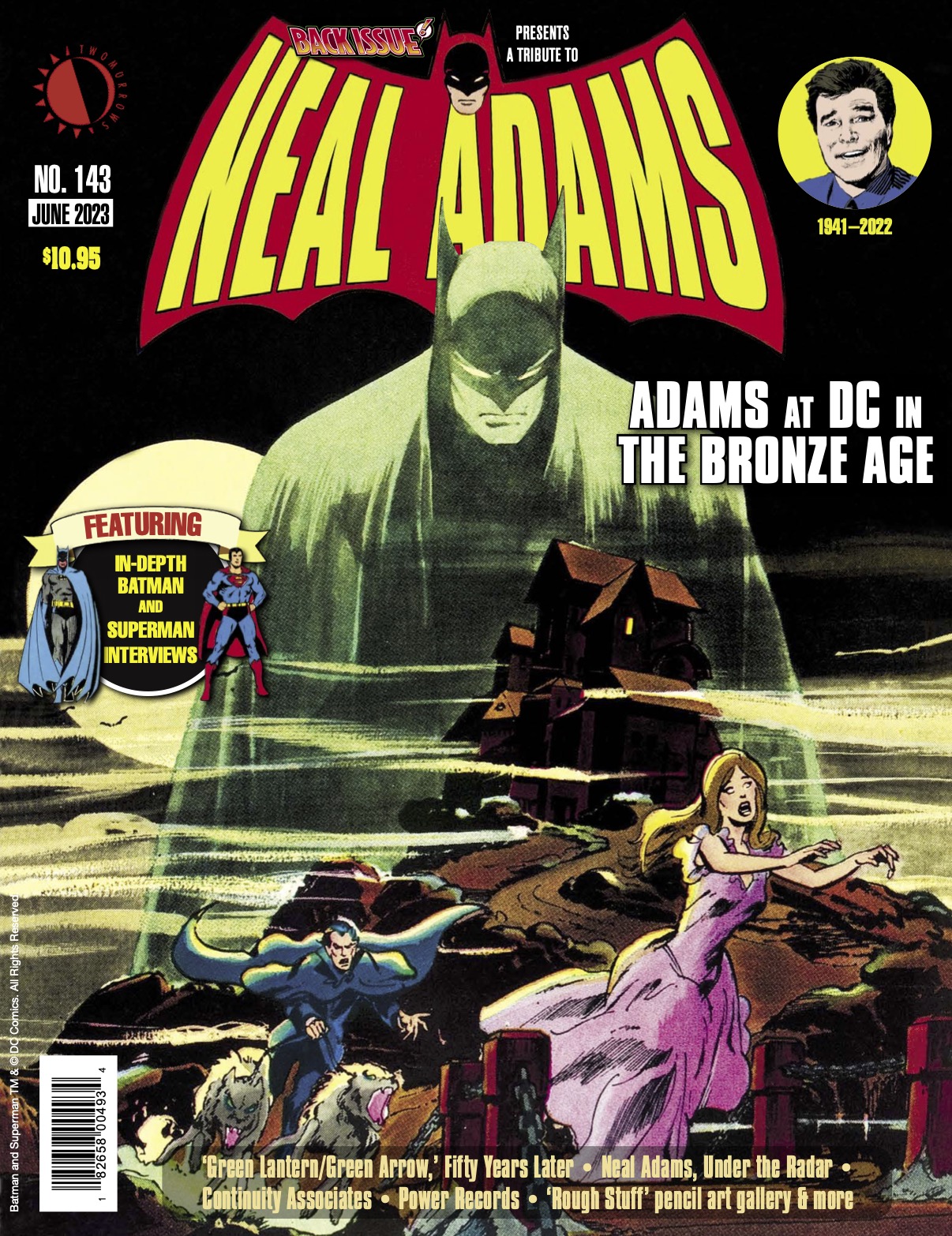
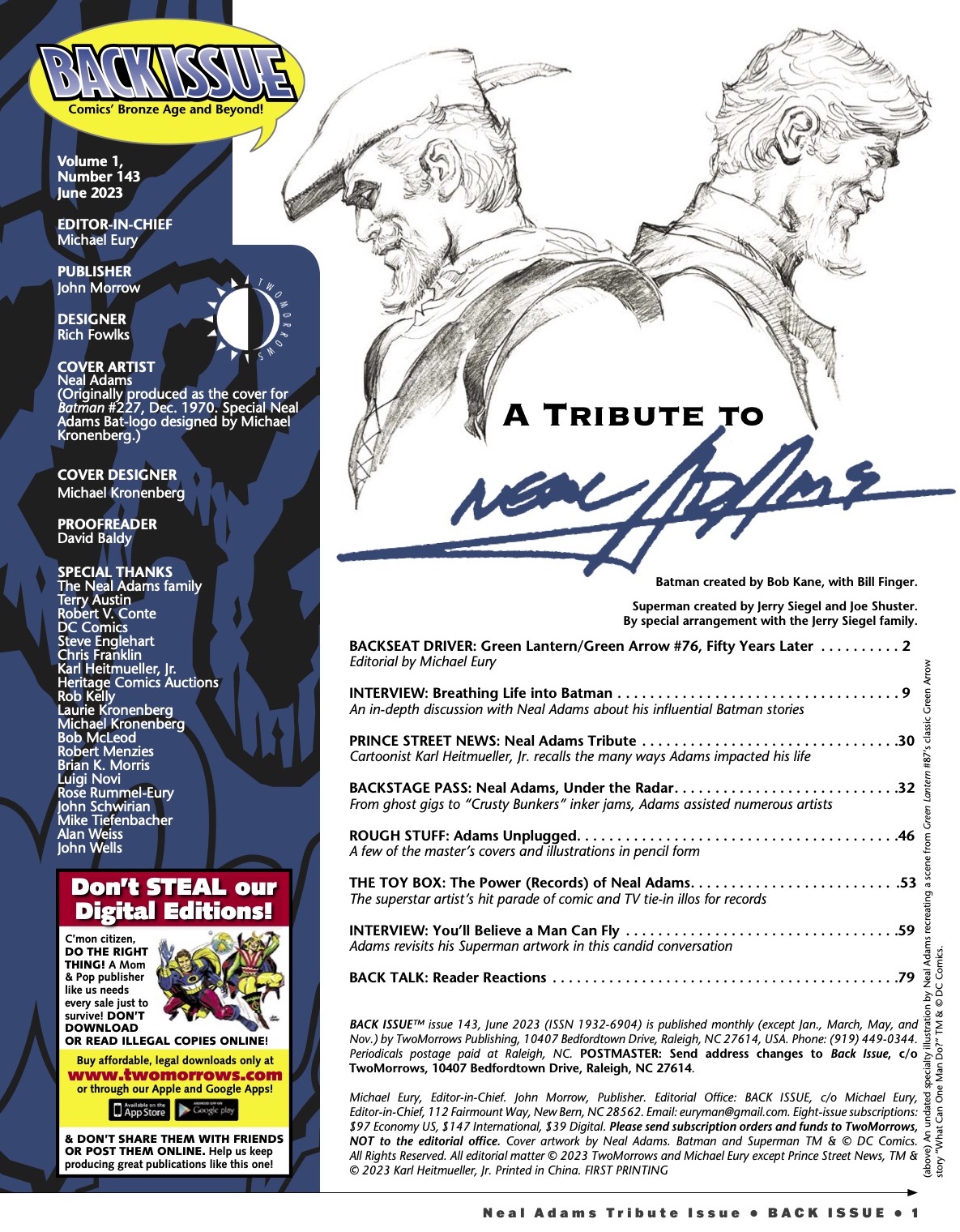
—
By JOHN WELLS
Would-be artist Steve Englehart had misgivings about his value as an assistant to Neal Adams in 1970, but the elder artist saw potential in the young man.
“I somehow had it in me one Friday afternoon,” Englehart tells Back Issue, “to travel from Aberdeen Proving Ground, Maryland, where I was stationed at the time, the time being mid-Vietnam war—to New York, to DC Comics, where I entered just before 5 o’clock. I asked if I could speak with Neal Adams, who liked to work there late on Fridays, which I somehow knew.
“In 1970, a fan in the office was a rarity, so they passed the word in, and Neal said yes. He, to me, was the epitome of comic art. Many people had that same idea, of course, but I was there to ask my idol, the greatest comic artist alive, if I might someday work with him, since I was an aspiring artist. I liked my art, so I can’t say I expected a brushoff from this guy I’d just met, but I knew what a crazy ask it was. Still, nothing ventured…
“Neal asked, ‘Why not now?’
“‘Because I’m in the Army, in Maryland, and I’ll be there a while.’
“‘Well, can you come up every Friday and work with me here, then spend Saturday at my house, then go back Sunday?’
“‘Uh, yes.’
“And so, for the next six months, that’s what I did. Work with Neal at DC till maybe 1 a.m., then off to a deli for food. I slept on a couch at Columbia, then went to Neal’s all day Saturday. He, by way of his wife, Cory, fed me lunch and dinner. I played with his kids.
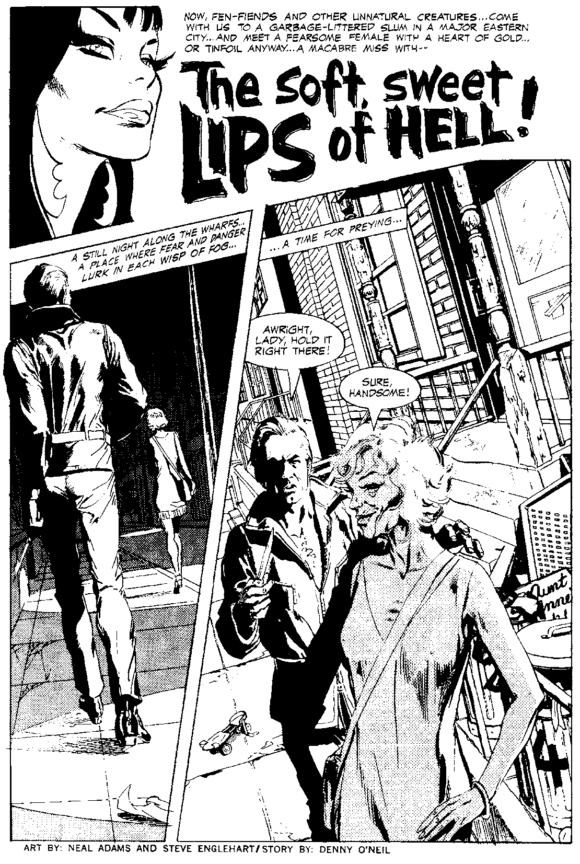
Vampirella #10
“Otherwise, I worked beside the greatest comic artist alive—who turned out to be, if it wasn’t already evident, a great guy besides. He put me to work on a Denny O’Neil script, a standalone horror story for Vampirella (#10, on sale in late 1970). I would lay out a page; he would pencil it. He would lay out the next page; I would pencil it – then he’d show me my mistakes. He insisted to Warren Publications that the art be credited to both of us, so that I’d have a published credit going forward. People did not credit their assistants then, but Neal did.
“Meanwhile, back in the Army, five days a week, I was a journalism specialist, assigned to the post newspaper. I had not been to Vietnam, but everyone I worked with had—and they had nothing good to say about it.
“The best summation of people’s attitude at that time was my sergeant, who got himself a glass ashtray and put an American flag decal on the bottom so you could see the flag through the glass. Most people saw that as a patriotic gesture, but he told me it was so he could stub out his cigarettes on the flag. I began to get a good picture of why they turned against the war—not the general societal antipathy toward it, but the clusterf*** it was, from people who’d seen it firsthand. It was literally a waste of people’s lives, on both sides of the war. But hey, what could I do, since I was already in the Army?

“Well, I applied for a conscientious objector discharge. To start with, Army protocol was, you applied for C.O. status before you went in—but what I was doing was allowed, barely. The process that then applied was, you had to be examined by a psychiatrist, a chaplain, and ‘an officer knowledge-able in matters pertaining to conscientious objection.’ The psychiatrist said I was sane, the chaplain said I was sincere—and then came the interview with what turned out to be a WAC major. To be a WAC, she would have had to have enlisted. To be a major, she would have had to reenlist. So, on paper, she was not going to be sympathetic to my cause.
“Meanwhile, back in New York, two days a week, I was finishing up ‘The Sweet Soft Lips of Hell,’ and of course talking to Neal about the above. I’m sure his general liberal attitude had bolstered mine over this time period, but he never advised me one way or the other as to applying for C.O. However, when it came time for the interview, he insisted on going down to Maryland, on his own time and his own dime, to testify for me.
“What else can I say? We did convince the major I was an upright citizen, so a few months later I left the Army and moved to New York to start my art career on my own, and eventually took a complete left turn into writing. But Neal was such a good storyteller that I learned from the best there, too, without knowing it.
“Neal Adams was an amazing human being. I was unbelievably lucky to have sat at his side.”
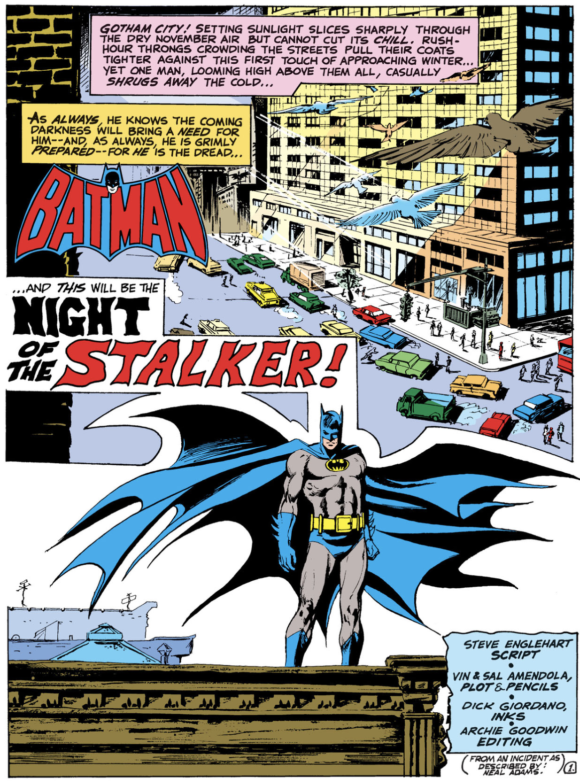
Adams and Englehart intersected again on a later Batman story, but young DC production man and budding artist Sal Amendola was at the heart of it. “Around 1970,” Amendola recalled in Comic Book Artist #3 (1999), “Neal Adams described an incident that he thought would be exciting to incorporate within a Batman story. He told the ‘incident’ over and over again to anybody who’d come into ‘the Artists’ Room’ at DC Comics. He told it each time as if it were the first. He was appropriately and effectively histrionic. I fought off goose pimples each time I heard him tell it. … Nobody took up Neal’s incident.”
With encouragement and input from his brother Vinny, Amendola worked up a story called “Déjà Vu,” wherein an enraged Batman pursued the perpetrators of a crime that echoed the murders of his own parents. The vivid underwater fight scene described by Adams appeared on pages 11 and 12. Amendola endured criticism from all quarters on a variety of details in his plot and pencils before Batman editor Julius Schwartz finally rejected the story as a whole because, “There’s no plot!”
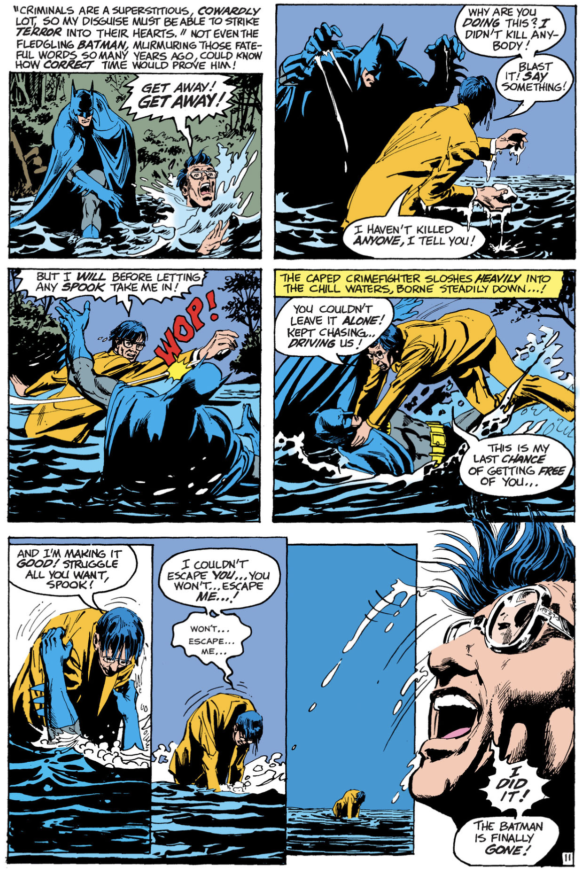
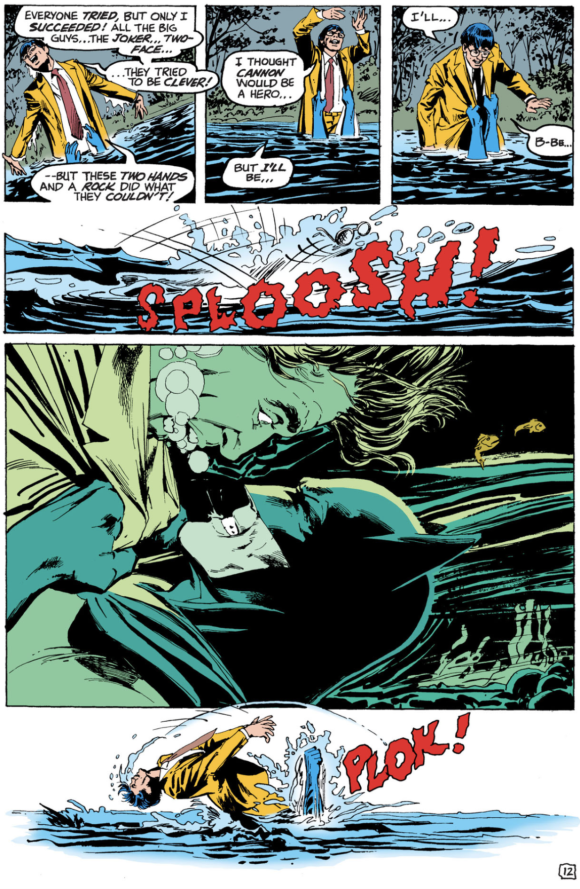
When Schwartz was briefly replaced as editor on Detective Comics, his successor Archie Goodwin asked Amendola for a look at the pencils and approved the tale for publication in Detective #439 (on sale in November 1973). Dialogued by Steve Englehart and inked by Dick Giordano, the story was retitled Night of the Stalker in its final form. Amendola objected to that “Marvel-style” title as well as the omission of any credit for Adams. “Since I also did the background inking,” he added in CBA #3, “when the story passed back to me from Dick, I lettered in Neal’s credit myself.” Ultimately, all involved were gratified by the hugely positive response to the story that included a Shazam Award nomination for Best Individual Dramatic Story.
—
Back Issue #143 is available now through TwoMorrows. Click here to order. It is due at comics shops and magazine sellers May 17.
—
MORE
— A NEAL ADAMS CHECKLIST: Your Guide to Comics’ Greatest Artist. Click here.
— STEVE ENGLEHART: ‘I Wanted to Do the Definitive BATMAN’. Click here.

May 13, 2023
Man, I really wish I could have met Neal and talked with him a bit. He seemed like not only a fascinating guy, but a good guy. My only other wish when it comes to Neal is that he could have done more regular interior work. He was so amazing as an artist, but his output was far less than a lot of his contemporaries. Having said that, the cover art he did was simply brilliant, and we might have lost some of those covers if he was doing more interior work, but, still – I wish he had done more interior art.
May 13, 2023
When Night of the Stalker received very positive response in the letter pages of Detective Comics, editor Goodwin modestly indicated that it was a story he simply inherited from previous editor Schwartz. However, this background now makes more sense: If Night of the Stalker was a viable Schwartz project, he could simply have published it in the main Batman title he continued to edit while Goodwin was looking after Detective. Schwartz rejecting it as lacking a typical DC gimmick-like “plot” sounds in character, although I hoped he would have been past that by 1973 after all the storytelling changes DC was going through in those years.
This is a great historical footnote to one of the all-time great Batman stories. Thanks!